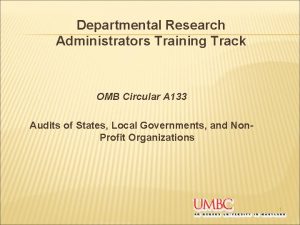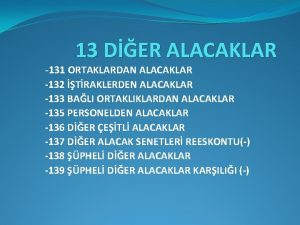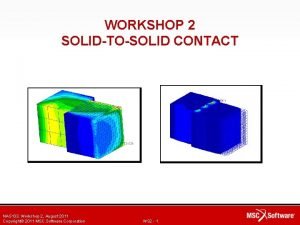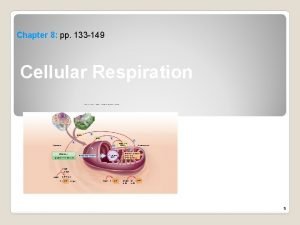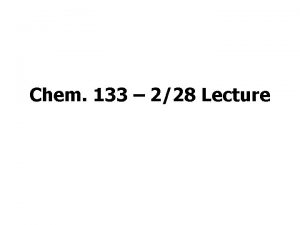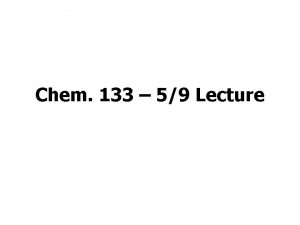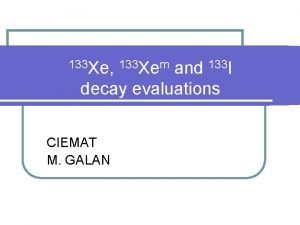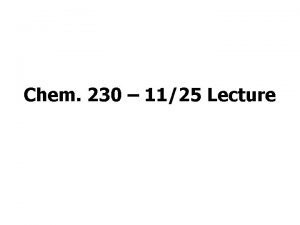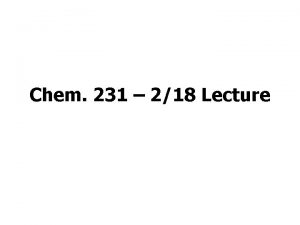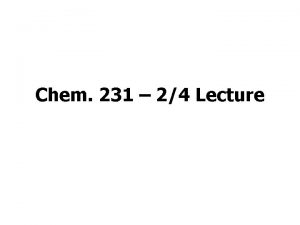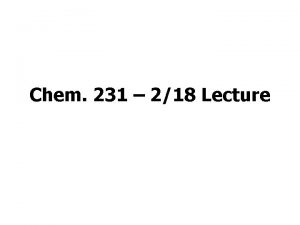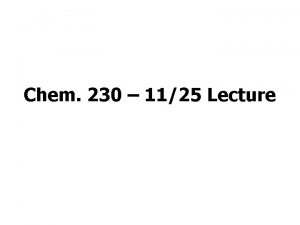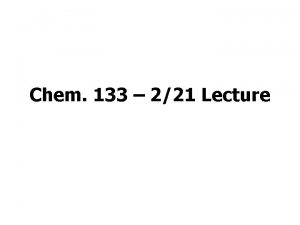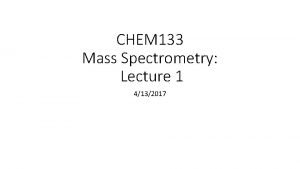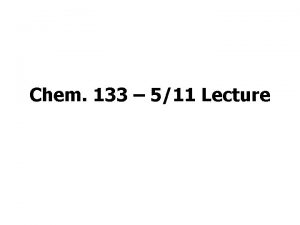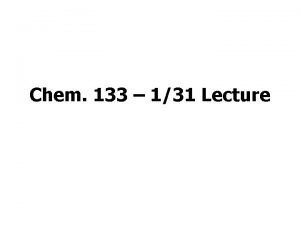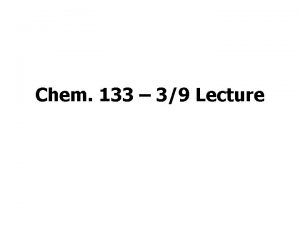Chem 133 52 Lecture Announcements Homework Set 3








![Chromatography Partition Theory • Partitioning in Chromatographic Columns – K = [X]s/[X]m where s Chromatography Partition Theory • Partitioning in Chromatographic Columns – K = [X]s/[X]m where s](https://slidetodoc.com/presentation_image_h2/c16e5fe2b3988feb565b6291196e21ed/image-9.jpg)











- Slides: 20

Chem. 133 – 5/2 Lecture

Announcements • Homework Set 3 – Posted – new due date for collected homework: 5/9 • Last Quiz – Thursday – on Mass Spectrometry Calculations • Today’s Lecture – Chromatography • Overview • Partitioning and Retention • Selectivity (if time)

Chromatography Overview • Chromatography is an area of “Separation Science” • Separation Science also includes other separation techniques (both instrumental, like capillary electrophoresis, and non-instrumental, like liquid extraction) • Main Purposes of Separations – Quantitative or qualitative analysis of unknown mixtures – Isolation of compounds (e. g. from reactions or from biological samples) • Main advantage/disadvantage vs. other methods: – Better for complex samples (separation gives selectivity) – Time required for separation to occur

Chromatography Instrument Overview • Chromatograph = instrument • Chromatogram = detection vs. time (vol. ) plot Chromatograph Components Sample In Chromatographic Column Flow/Pressure Control Mobile Phase Reservoir Injector Signal to data recorder Detector Waste or fraction collection Chromatogram

Chromatography Partition Theory • All Chromatographic separations involve partitioning between distinct phases (mobile phase and stationary phase) • The first part of Chapter 22 -1 deals with liquid – liquid extractions (covered only for understand of partitioning) • Liquid-liquid extraction involves two liquid phases (top phase is less dense) • An analyte (X) will partition between the two phases until equilibrium is reached • Phase 1 = initial (or raffinate) phase, phase 2 = extract phase, K = partition coefficient = constant organic phase X(org) X(aq) aqueous phase

Chromatography Partition Theory • Partitioning between phases is more complicated when analyte changes forms in one phase • Example: phenol (HA) extraction from water to octanol – – partitioning of HA reaches an equilibrium however, HA can exist as HA (acid form) or A- (base form) A- only will exist in water, not in octanol (KA- = 0) A distribution coefficient, D, describes the partitioning of total forms of phenol between two phases – While K is p. H independent, D depends on p. H (lower equation derived from combining D equation with Ka equation) – D ~ K at low p. H, while at high p. H, D gets small

Chromatography Questions on Partition Theory 1. The compound 1 -butanol has a hexane – water partition ratio (K = [1 -but]hexane/[1 -but]water) of 11. Will its partition ratio for diethyl ether – water be greater or smaller? 2. Methyl and ethyl amines are indicators of fish spoilage and are basic (conjugate acids have p. Ka values around 10 to 11). It is desired to remove the amines from hydrophobic compounds in fish by liquid – liquid extraction using ethyl acetate and water. What p. H should be used and in which phase will the amines reside?

Chromatography Separation Theory: The good, the bad and the ugly • The Good: Separation based on differential partitioning (differences in K) • The Bad: Band Broadening (limits separation efficiency and dilutes analytes) • The Ugly: Non-ideal behavior (causes non. Gaussian peak shapes)
![Chromatography Partition Theory Partitioning in Chromatographic Columns K XsXm where s Chromatography Partition Theory • Partitioning in Chromatographic Columns – K = [X]s/[X]m where s](https://slidetodoc.com/presentation_image_h2/c16e5fe2b3988feb565b6291196e21ed/image-9.jpg)
Chromatography Partition Theory • Partitioning in Chromatographic Columns – K = [X]s/[X]m where s is for stationary phase and m is for mobile phase – Above equation is designed where mobile and stationary phases are liquids, but a related equation can be used with other phases (e. g. gas mobile phase in GC) – K value affects how long it takes a solute to go through column because the solute is only moving when it is in the mobile phase – Solutes with larger K values (e. g. Y below) move through columns more slowly Y X

Chromatography Basis for Separation • The partition coefficient (K) is not used that much in chromatography • In its place is k, the retention factor • k = ns/nm where n = moles of analyte (in stationary and mobile phases) • k is used because it is easily measured tr = retention time = total time spent on column tm = time required for mobile phase to flow through column (every compound spends the same time in the mobile phase)

Chromatography More on Stationary Phases Open Tubular (end on, cross section view) Packed column (side view) (e. g. Silica in normal phase HPLC) Column Wall Mobile phase Stationary phase (wall coating) Expanded View Packing Material Stationary phase is outer surface Bonded phase (liquid-like) Stationary Phase Chemically bonded to packing material Packing Material View showing pores

Chromatography Parameters from Chromatograms • Determination of parameters from reading chromatogram (HPLC example) • t. M = 2. 37 min. (normally determined by finding 1 st peak for unretained compounds – contaminant below) • 1 st peak, t. R = 4. 96 min. • k (1 st peak) = (4. 96 -2. 37 min. )/2. 37 min. = 1. 09

Chromatography Flow – Volume – Time Relationship • Chromatographic parameters can be expressed in terms of volume or time • V = F·t where F = volume flow rate • tm also can be determined as Vm/F • k can be related to K through volumes: note: Vs is often hard to measure • k can be increased by increasing K or Vs/Vm

Chromatography Retention Factor Values • Practical k values – ~0. 5 to ~10 – Small k values → interference more likely – Large k values → must wait long time • Changing k values – Can change: • Vm/Vs – requires column change so less desired • K – this can be an “adjustment” without needing a column change

Chromatography Changing k - GC • – k adjustment in GC – – • • k depends on volatility and polarity Smaller k for more volatile analytes Smaller k for analytes less like column polarity (e. g. polar compounds with non-polar column) Volatility depends on T Temperature controlled with oven at low T, compounds are less volatile and spend more time in stationary phase, so k is larger at low T k also can be changed by changing column polarity (more expensive/less desired method)

Chromatography Changing k - HPLC • k in HPLC – – – k depends on polarity of analyte, mobile and stationary phases Mobile and stationary phases are usually opposite in polarity (best when analytes with intermediate polarity elute) Normal-phase HPLC is with a polar stationary phase and non-polar eluent (e. g. hexane + 2 -propanol) In the normal-phase example, Analyte X elutes before Analyte Y For reversed-phase HPLC (non-polar stationary phase, polar mobile phase), elution order is reversed Polarity Index hexane non-polar C 18 Analyte X Analyte Y 2 -propanol methanol Si. OH water polar

Chromatography Changing k – HPLC – cont. • k adjustment in HPLC – – Increasing “strong” solvent decreases k Strong solvent is one more like stationary phase (2 -propanol in normal-phase or methanol in reversed-phase) for reversed-phase HPLC Increasing % methanol decreases k opposite change needed in normalphase HPLC (polar stationary phase) Polarity Index hexane non-polar C 18 Analyte X 2 -propanol methanol Si. OH water polar

Chromatography Some Questions 1. 2. 3. 4. List 3 main components of chromatographs. A chemist purchases a new open tubular GC column that is identical to the old GC column except for having a greater film thickness of stationary phase. How will the following parameters will be affected (assuming column run as before): K, k, t. M, t. R(component X)? What “easy” change can be made to increase k in GC? In normal phase HPLC using a hexane/ethylacetate mobile phase? A GC is operated close to the maximum column temperature and for a desired analyte, k = 10. Is this good? What change could be made to improve the analysis?

Chromatography Selectivity • Selectivity is given by a= relative retention (also called selectivity coefficient) • a = ky/kx (where tr(y) > tr(x)) • A larger a value means a better separation. An a value close to 1 means a difficult separation. • Note that a = Ky/Kx also applies

Chromatography Selectivity – cont. • Determination of parameters from reading chromatogram (HPLC example) • a (for 1 st 2 peaks) = k. B/ k. A = t. RB’/ t. RA’ = (5. 757 – 2. 374)/(4. 958 – 2. 374) = 1. 31
 Total set awareness set consideration set
Total set awareness set consideration set Training set validation set test set
Training set validation set test set R/announcements
R/announcements General announcements
General announcements David ritthaler
David ritthaler What does montag hear in the seashell
What does montag hear in the seashell Pvu announcements
Pvu announcements Kayl announcements
Kayl announcements 01:640:244 lecture notes - lecture 15: plat, idah, farad
01:640:244 lecture notes - lecture 15: plat, idah, farad Homework oh homework i hate you you stink
Homework oh homework i hate you you stink Literal language example
Literal language example Parts of a poem
Parts of a poem Jack prelutsky homework oh homework
Jack prelutsky homework oh homework Homework oh homework i hate you you stink
Homework oh homework i hate you you stink Alitteration definition
Alitteration definition Omb circular a 133 audit
Omb circular a 133 audit Nova cesta 133
Nova cesta 133 Bağlı ortaklardan alacaklar hesabı
Bağlı ortaklardan alacaklar hesabı Nas 133
Nas 133 Copyright
Copyright Hpd 136 uitm
Hpd 136 uitm















